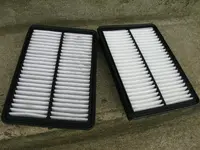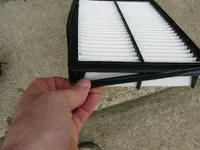I've been meaning to change my air filter for a while now, I have 22k miles on my second Mazda air filter and the clean side was starting to get black spots so I figured today was the day. Ive always bought OEM air & oil filters for the past 4 new vehicles I bought. I found the quality and price were comparable to aftermarkets if not better. Today I missed the Mazda dealership being open so I decided to stop by an Advanced Auto and get a Purolator as theyve always been a favorite brand in the past. I took the old filter out and as I took the Purolator out of the box I noticed the rubber around the edges felt flimsy compared to the Mazda filter which felt more solidly built. Upon further notice I saw that the rubber around the edges wasnt even part of the filter, it was sort of a flimsy rubber gasket attached to it. Looks like aftermarket-same-as really isnt. Ive no reason to believe itll filter any differently, but from now on its strictly OEM for a mere 3 bucks more.






